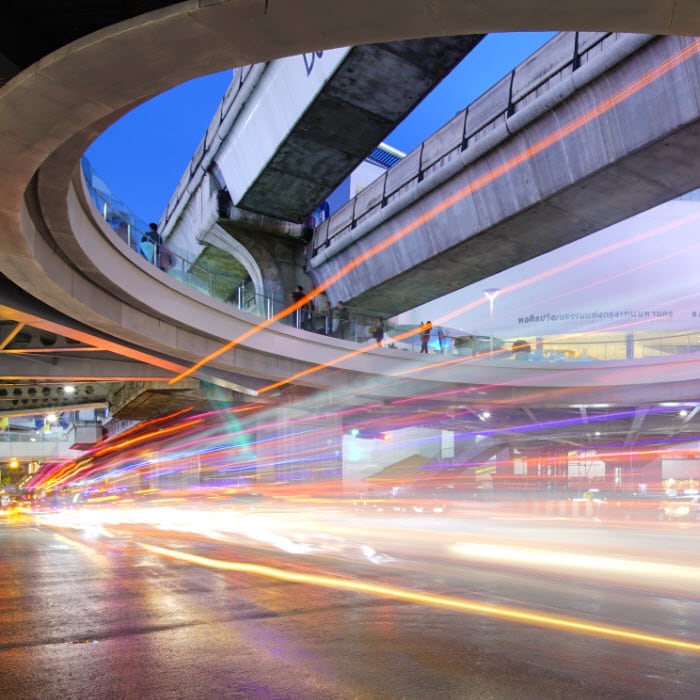Can public-private investments save infrastructure? has been saved

Perspectives
Can public-private investments save infrastructure?
From the Wall Street Journal’s Risk & Compliance Journal
Crumbling infrastructure, paired with emerging technologies and travel patterns, has led a growing number of government agencies to align with private-sector partners to overcome obstacles and bankroll new construction. Deloitte looks at the challenges and opportunities these emerging partnerships present.
Can public-private investments save infrastructure?
Numerous governmental bodies dealing with outdated, dilapidated infrastructure face a twofold challenge. Upgrades are necessary to meet current demands, but those improvements must also be optimized for future use—and that may be difficult to define, given rapid advances in technology and changing consumer expectations.
Many agencies are working to remedy a growing realization that the traditional taxation model used to fund infrastructure at federal, state, and local levels has not kept pace with expanding demands, nor is it fit for meeting future needs, says Avi Schwartz, principal, Deloitte Risk & Financial Advisory, Deloitte Transactions and Business Analytics LLP.
"Infrastructure funding and delivery approaches in the United States have remained relatively unchanged for at least a half-century," says Schwartz. "Now we’re beginning to see several disruptors that are affecting not only how transportation is built, but also how it is maintained and operated. We are seeing new ways of developing and executing projects, fresh approaches to funding them, and innovative ideas about how to upgrade and adapt infrastructure to meet future needs."

Building for tomorrow
Current roads, bridges, and highways are built to accommodate a variety of vehicle types, and they are clogged beyond capacity along major corridors and in more urban areas. "Transportation of the future will include more vehicles that are electric, automated, and connected," says Bryan Nicol, managing director, Deloitte Risk & Financial Advisory, Deloitte Transactions and Business Analytics LLP. Rural areas will be served by more automated-shuttle types of services. Freight and truck traffic might be segregated in certain corridors from passenger vehicles to make transportation safer and more efficient.
"What we need in the future may be very different from what we have today," says Nicol. “There will be more sensors, cameras, and other technologies built into roadways. Lane widths will likely change to adapt to these new technologies and new electric, connected, and automated vehicles. That raises a lot of questions about what should be built or rebuilt today to serve communities well into the future.”
Technology presents a significant opportunity to make transportation more efficient in a number of intriguing ways, but planning in the present for future use is challenging, says Josephine Tucker, senior manager, Deloitte Risk & Financial Advisory, Deloitte Transactions and Business Analytics LLP. Technology such as ride-sharing apps and GPS systems can be taken to another level so that consumers can plan personal transportation considering a multitude of factors.
We are seeing new ways of developing and executing projects, fresh approaches to funding them, and innovative ideas about how to upgrade and adapt infrastructure to meet future needs.
—Avi Schwartz, principal, Deloitte Transactions and Business Analytics LLP.
A single app, for example, might help a consumer decide whether a given trip is best accomplished with a personal vehicle, rail service, rideshare, scooter or bicycle rental, or some combination. The same app might allow the consumer to state preferences for the route that is the fastest, the cheapest, or the greenest.
Such technologies also can produce data to inform the transportation planning process, says Tucker, enabling priority focus on projects that matter most. "If we think about how we optimize technology and take advantage of efficiencies, we may not need to build as much infrastructure in the future as we have in the past," says Tucker. “We are not likely to see the same kind of infrastructure build in the next 50 years that we have seen in the past 50 years."

Investors are ready
In major metropolitan areas like New York and San Diego, officials recognize the need to rethink transportation systems, and many are forming partnerships with private-sector participants. A growing number of public-private partnerships, often called P3s, are developing bold plans to reimagine and transform infrastructure, says Schwartz. "Private-sector participants in infrastructure initiatives may be involved with funding, planning, and constructing projects, and may also have a role in managing and maintaining them into the future. Investors are showing increasing interest in such projects although they often raise questions that are sometimes challenging to answer."
"Savvy investors look for accountability, so they want transparency," says Schwartz. "Investors want confidence that the project is going to deliver an asset, on time and within budget and that it will generate revenue and returns."
Many government entities pursuing P3s are demonstrating their commitment by deploying new systems and new technologies that are designed to improve capabilities to meet investor expectations. "All of this is helping to bring together the right people and the right technology into a programmatic, strategic approach to produce new infrastructure assets that communities need," explains Schwartz.
P3s provide significant potential to bring about needed transformation in current infrastructure, says Nicol. "These are risk-sharing arrangements between the public sector and private entities that develop assets traditionally constructed and managed within the public realm," he adds. "There are great opportunities to enhance mobility, relieve congestion, and improve safety."
Although transportation upgrades are a significant focus of the P3 movement, other infrastructure elements need improvement and are benefiting from similar arrangements, says Nicol. Projects are under construction and consideration in certain parts of the country to build not only highways, but also tunnels, bridges, airports, rail systems, utilities, and communications infrastructure.
Not every agency charged with infrastructure responsibility is forming P3s, however. In certain jurisdictions, legislative solutions are necessary to remove legal obstacles to the formation of P3s. Partnerships can also be challenging to form among government bodies and private-sector participants who may have different approaches to conducting their respective businesses and different expectations in terms of process and outcomes.
Some projects lend themselves to P3s more than others, according to Nicol. Broadband Internet connections, for example, involve a substantial capital outlay with a significant consumer service component, making them intriguing opportunities for private-sector investors.
Commercial entities reliant on trucks for cargo transport might also have a logical interest in developing a new method for transferring goods that would separate cargo from humans, making the system safer and more efficient, says Nicol. Example projects exploring whether automation and machine learning can be leveraged in such a way are in process, and AI likely will be the norm in the coming decade driving efficiencies in all modes of transportation.
“The optimization of infrastructure as assets is a complex undertaking, but one with significant risks and opportunities for both the public and private sector to manage and leverage,” says Schwartz.
This content was originally published on the Wall Street Journal Risk & Compliance Journal.

Recommendations
Leading practices in infrastructure investment
Identifying and overcoming infrastructure gaps


